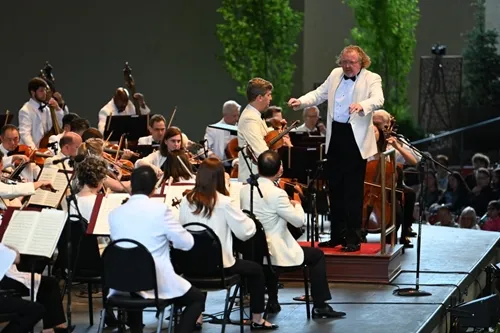
Nestled in the embrace of pine trees and an Alpine garden, with majestic mountains as the backdrop, the Gerald R. Ford Amphitheater provided an idyllic setting for the nature-inspired melodies of Beethoven's "Pastoral" Symphony No. 6 on Friday night in Vail.
Beethoven's creative spirit thrived whenever he escaped the sensory overload of his adopted city, Vienna, and immersed himself in the countryside. When he wrote in 1810, "Surely woods, trees, and rocks produce the echo that man desires to hear," one could easily imagine that he had envisioned a venue like this for the performance of his five-movement masterpiece.
Beethoven scattered phrases throughout the score, such as "the listener should be allowed to discover the situations." On Friday, the esteemed guest conductor, Stéphane Denève, who has become a familiar face at Bravo! Vail, recognized the potential of incorporating real-life sound effects to enhance the composer's intended expressions.
Denève led the orchestra through the first part of the evening, featuring a mesmerizing performance of Beethoven's violin concerto in D major by James Ehnes, a talented graduate of the Juilliard School. Ehnes maintained a rich and full-bodied tone as he effortlessly navigated the intricate passages on his "Marsick" Stradivarius violin from 1715. His playing seamlessly soared into the higher registers, which are notoriously demanding.
The timpani introduced the concerto with a distinctive five-note motif, their sound traveling through the ensemble. As the motif passed from trumpet to oboe, one couldn't help but notice the orchestra's unified and harmonious sound, as pristine and coordinated as their attire of white tops and tuxedo jackets. The French Horns displayed exceptional clarity, providing impeccable support to the soloist through exposed chords, fanfares, and a dazzling staccato run in the final movement. Their ability to blend brevity with fullness, always striking with perfect accuracy in their attacks and releases, was particularly noteworthy.
During Ehnes' second-movement cadenza, a gentle breeze circulated through the entire auditorium, playfully flipping the pages of Denève's score. Oblivious to the spectacle, Denève remained focused on his soloist, seemingly captivated alongside the mesmerized audience. As Ehnes signaled the end of the cadenza, Denève's attention returned to the podium, calmly rectifying the page-turning mishap and finding the correct measure before the synchronized bows resolved the harmonious tension.
Later, the winds introduced syncopation in the third movement, propelling it towards its grand finale. As Ehnes played his final note, he looked up to receive a well-deserved standing ovation.
"Oh, it was magnificent!" an enthusiastic audience member in section three exclaimed after Ehnes' encore performance of Paganini's Caprice No. 16. Pumping his fist in support of the virtuoso, he turned to his companion and added, "And... the violinist is Canadian!"
After the intermission, Denève set the stage for the al fresco musical feast of the sixth symphony. To prepare the audience for the first movement, titled "Awakening of Cheerful Feelings upon Arrival in the Country," he urged, "No cell phones, no screens—just immerse yourself in the real experience."
While Vail's breathtaking natural surroundings made it relatively easy to comply with such a request, the town's unique culture sometimes interfered. Only at the Gerald R. Ford Amphitheater would one find a man wearing a Jumbo-Visma cycling kit streaming stage six of the Tour de France on his phone during the intermission of a Philadelphia Orchestra concert, sitting in the front row.
"Are you a Sepp Kuss fan?" someone asked, referring to the cyclist from Durango, Colorado, who was a member of the Jumbo-Visma team.
"I'm Primož Roglič's cousin," came the reply. There's an old saying that goes: you can take the man out of the peloton, but you can't take the peloton out of the man (or the sports story of the evening, I suppose).
As the string section enveloped the audience with their lush melodies, a sense of gentle motion was evoked from the very first beat. Similar to the lively occurrences in nature, delicate runs by the violins and violas conjured images of critters scurrying along the forest floor and chickadees playfully chasing each other from branch to branch. When the bassoon playfully exchanged motifs with the front row, one couldn't help but imagine a pair of chipmunks engaged in a game of tag beneath an aspen tree.
Interestingly, the first chirps of the birds did not originate from the woodwind section, as Beethoven intended and Denève had cautioned. Instead, the local avian flock soaring above the rafters of the amphitheater seemed to have forgotten their cues and began their song before principal flute Jeffrey Khaner and the entire woodwind section painted the scene with their imaginative melodies.
Source: vaidaily.com



